Research Trends in Career Success: A Bibliometric Review
Abstract
1. Introduction
2. Materials and Methods
2.1. Criteria Search of the Field
2.2. Selection of Database and Documents
2.3. Selection Criteria
2.4. Software and Data Selection
2.5. Analysis and Results
3. Results
3.1. Performance Analysis
3.1.1. Scientific Production Analysis
3.1.2. Contributions by Countries
3.1.3. Featured Authors
3.1.4. Frequently Cited Documents
3.1.5. Journal Performance
3.2. Science Mapping
3.2.1. Co-occurrence Network of Author Keywords
3.2.2. Cited authors Co-Citation Network
3.2.3. Scientific Cited Sources Co-Citation Network
4. Discussion
5. Conclusions
Supplementary Materials
Author Contributions
Funding
Institutional Review Board Statement
Informed Consent Statement
Data Availability Statement
Acknowledgments
Conflicts of Interest
References
- Ummatqul Qizi, K.N. Soft skills development in higher education. Univers. J. Educ. Res. 2020, 8, 1916–1925. [Google Scholar] [CrossRef]
- Pacáková, Z.; Jindrová, A. Information Benefit of Graduates Follow-up Surveys. J. Effic. Responsib. Educ. Sci. 2011, 4, 129–141. [Google Scholar]
- Oplatka, I.; Mimon, R. Women principals’ conceptions of job satisfaction and dissatisfaction: An alternative view? Int. J. Leadersh. Educ. 2008, 11, 135–153. [Google Scholar] [CrossRef]
- Aryee, S.; Chay, Y.W.; Tan, H.H. An Examination of the Antecedents of Subjective Career Success Among a Managerial Sample in Singapore. Hum. Relat. 1994, 47, 487–509. [Google Scholar] [CrossRef]
- Seibert, S.E.; Kraimer, M.L. The Five-Factor Model of Personality and Career Success. J. Vocat. Behav. 2001, 58, 1–21. [Google Scholar] [CrossRef]
- NG, T.W.H.; Eby, L.T.; Sorensen, K.L.; Feldman, D.C. Predictors of Objective and Subjective Career Success: A Meta-Analysis. Pers. Psychol. 2005, 58, 367–408. [Google Scholar] [CrossRef]
- Judge, T.A.; Bretz, R.D. Political Influence Behavior and Career Success. J. Manag. 1994, 20, 43–65. [Google Scholar] [CrossRef]
- Seibert, S.E.; Crant, J.M.; Kraimer, M.L. Proactive personality and career success. J. Appl. Psychol. 1999, 84, 416–427. [Google Scholar] [CrossRef]
- Gattiker, U.E.; Larwood, L. Subjective career success: A study of managers and support personnel. J. Bus. Psychol. 1986, 1, 78–94. [Google Scholar] [CrossRef]
- Kirchmeyer, C. Determinants of Managerial Career Success: Evidence and Explanation of Male/Female Differences. J. Manag. 1998, 24, 673–692. [Google Scholar] [CrossRef]
- Peluchette, J.V.E. Subjective Career Success: The Influence of Individual Difference, Family, and Organizational Variables. J. Vocat. Behav. 1993, 43, 198–208. [Google Scholar] [CrossRef]
- NG, T.W.H.; Feldman, D.C. Subjective career success: A meta-analytic review. J. Vocat. Behav. 2014, 85, 169–179. [Google Scholar] [CrossRef]
- Cope, P.M. The Women of “Who’s Who”: A Statistical Study. Soc. Forces 1928, 7, 212–223. [Google Scholar] [CrossRef]
- Heslin, P.A. Conceptualizing and evaluating career success. J. Organ. Behav. 2005, 26, 113–136. [Google Scholar] [CrossRef]
- Raluy Alonso, Á. El concepto estadounidense de “éxito” frente a su homónimo español: Dos visiones sociológica, semántica y etimológicamente diferentes. ELUA. Estud. Lingüíst. Univ. Alicant. 2012, 269–288. [Google Scholar] [CrossRef]
- Canal Domínguez, J.F.; Rodríguez Gutiérrez, C. Universidad pública frente a universidad privada: ¿qué efectos tiene sobre el éxito profesional de los universitarios españoles?/A Public University or a Private University: What Effect does this Choice have on the Professional Success of Graduates in S. Rev. Esp. Investig. Sociol. 2020, 169. [Google Scholar] [CrossRef]
- Delgado, A.; Saletti-Cuesta, L.; López-Fernández, L.A.; Toro-Cárdenas, S.; Luna del Castillo, J.d.D. Professional Success and Gender in Family Medicine. Eval. Health Prof. 2016, 39, 87–99. [Google Scholar] [CrossRef]
- Tlaiss, H.; Kauser, S. The importance of wasta in the career success of Middle Eastern managers. J. Eur. Ind. Train. 2011, 35, 467–486. [Google Scholar] [CrossRef]
- Spangler, W.D. Validity of questionnaire and TAT measures of need for achievement: Two meta-analyses. Psychol. Bull. 1992, 112, 140–154. [Google Scholar] [CrossRef]
- Kim, M.; Beehr, T.A. Can Empowering Leaders Affect Subordinates’ Well-Being and Careers Because They Encourage Subordinates’ Job Crafting Behaviors? J. Leadersh. Organ. Stud. 2018, 25, 184–196. [Google Scholar] [CrossRef]
- Niu, Y.; Hunter-Johnson, Y.; Xu, X.; Liu, T. Self-Perceived Employability and Subjective Career Success: Graduates of a Workforce Education and Development Program. J. Contin. High. Educ. 2019, 67, 55–71. [Google Scholar] [CrossRef]
- Walsh, L.C.; Boehm, J.K.; Lyubomirsky, S. Does Happiness Promote Career Success? Revisiting the Evidence. J. Career Assess. 2018, 26, 199–219. [Google Scholar] [CrossRef]
- Crompton, R.; Lyonette, C. Women’s Career Success and Work-life Adaptations in the Accountancy and Medical Professions in Britain. Gender Work Organ. 2011, 18, 231–254. [Google Scholar] [CrossRef]
- Goh, S.C. Sex differences in perceptions of interpersonal work style, career emphasis, supervisory mentoring behavior, and job satisfaction. Sex Roles 1991, 24, 701–710. [Google Scholar] [CrossRef]
- De Haro, J. El Papel de la Inteligencia General, la Personalidad y la Inteligencia Emocional en el Éxito Profesional al Inicio de la Carrera; Universidad de Alicante: San Vicente del Raspeig, Spain, 2014. [Google Scholar]
- Koh, H.C.; Boo, E.H.Y. The link between organizational ethics and job satisfaction: A study of managers in Singapore. J. Bus. Ethics 2001, 29, 309–324. [Google Scholar] [CrossRef]
- Judiesch, M.K.; Lyness, K.S. Left Behind? The Impact of Leaves of Absence on Managers’ Career Success. Acad. Manag. J. 1999, 42, 641–651. [Google Scholar] [CrossRef]
- Forest, J.; Mageau, G.A.; Sarrazin, C.; Morin, E.M. “Work is my passion”: The different affective, behavioural, and cognitive consequences of harmonious and obsessive passion toward work. Can. J. Adm. Sci. Rev. Can. Sci. Adm. 2011, 28, 27–40. [Google Scholar] [CrossRef]
- Robinson, D.A.G.; Reilly, B.A. Women Engineers: A Study of Educational Preparation and Professional Success. J. Eng. Educ. 1993, 82, 78–82. [Google Scholar] [CrossRef]
- Pinelli, T.E.; Barclay, R.O.; Kennedy, J.M. Workplace communications skills and the value of communications and information use skills instruction-engineering students’ perspectives. In Proceedings of the 1995 IEEE International Professional Communication Conference. IPCC 95 Proceedings. Smooth Sailing to the Future; IEEE: Savannah, GA, USA, 1995; pp. 161–165. [Google Scholar]
- Burke, R.J.; Kurucz, E. Demographic Characteristics of Canadian Women Corporate Directors. Psychol. Rep. 1998, 83, 461–462. [Google Scholar] [CrossRef]
- Morreale, S.P.; Pearson, J.C. Why Communication Education is Important: The Centrality of the Discipline in the 21st Century. Commun. Educ. 2008, 57, 224–240. [Google Scholar] [CrossRef]
- Costa, P.T.J.; McCrae, R.R. NEO PI-R. Revised Neo Personality Inventory and NEO Five-Factor Inventory (NEO-FFI); Psychological Assessment Resources: Odessa, FL, USA, 2008. [Google Scholar]
- Khan, M.B.; Kukalis, S. MIS professionals: Education and performance. Inf. Manag. 1990, 19, 249–255. [Google Scholar] [CrossRef]
- Wiggins, C.; Bowman, S.Y. Career Success and Life Satisfaction for Female and Male Healthcare Managers. Hosp. Top. 2000, 78, 5–10. [Google Scholar] [CrossRef] [PubMed]
- Buckley, L.M.; Sanders, K.; Shih, M.; Hampton, C.L. Attitudes of Clinical Faculty About Career Progress, Career Success and Recognition, and Commitment to Academic Medicine. Arch. Intern. Med. 2000, 160, 2625. [Google Scholar] [CrossRef]
- Knouse, S.B. Virtual mentors: Mentoring on the internet. J. Employ. Couns. 2001, 38, 162–169. [Google Scholar] [CrossRef]
- Afarian, R.; Kleiner, B.H. The relationship between grades and career success. Manag. Res. News 2003, 26, 42–51. [Google Scholar] [CrossRef]
- McDonald, K.S.; Hite, L.M. The Next Generation of Career Success: Implications for HRD. Adv. Dev. Hum. Resour. 2008, 10, 86–103. [Google Scholar] [CrossRef]
- Gault, J.; Redington, J.; Schlager, T. Undergraduate Business Internships and Career Success: Are They Related? J. Mark. Educ. 2000, 22, 45–53. [Google Scholar] [CrossRef]
- Cobo, M.J.; Martínez, M.A.; Gutiérrez-Salcedo, M.; Fujita, H.; Herrera-Viedma, E. 25years at Knowledge-Based Systems: A bibliometric analysis. Knowl. Based Syst. 2015, 80, 3–13. [Google Scholar] [CrossRef]
- Li, T.; Ho, Y.-S.; Li, C.-Y. Bibliometric analysis on global Parkinson’s disease research trends during 1991. Neurosci. Lett. 2008, 441, 248–252. [Google Scholar] [CrossRef] [PubMed]
- Van Eck, N.J.; Waltman, L. Citation-based clustering of publications using CitNetExplorer and VOSviewer. Scientometrics 2017, 111, 1053–1070. [Google Scholar] [CrossRef]
- Tranfield, D.; Denyer, D.; Smart, P. Towards a Methodology for Developing Evidence-Informed Management Knowledge by Means of Systematic Review. Br. J. Manag. 2003, 14, 207–222. [Google Scholar] [CrossRef]
- Fahimnia, B.; Sarkis, J.; Davarzani, H. Green supply chain management: A review and bibliometric analysis. Int. J. Prod. Econ. 2015, 162, 101–114. [Google Scholar] [CrossRef]
- Herrera-Franco, G.; Montalván-Burbano, N.; Carrión-Mero, P.; Apolo-Masache, B.; Jaya-Montalvo, M. Research Trends in Geotourism: A Bibliometric Analysis Using the Scopus Database. Geosciences 2020, 10, 379. [Google Scholar] [CrossRef]
- Keathley-Herring, H.; Van Aken, E.; Gonzalez-Aleu, F.; Deschamps, F.; Letens, G.; Orlandini, P.C. Assessing the maturity of a research area: Bibliometric review and proposed framework. Scientometrics 2016, 109, 927–951. [Google Scholar] [CrossRef]
- Do Prado, J.W.; de Castro Alcântara, V.; de Melo Carvalho, F.; Vieira, K.C.; Machado, L.K.C.; Tonelli, D.F. Multivariate analysis of credit risk and bankruptcy research data: A bibliometric study involving different knowledge fields (1968–2014). Scientometrics 2016, 106, 1007–1029. [Google Scholar] [CrossRef]
- Merigó, J.M.; Blanco-Mesa, F.; Gil-Lafuente, A.M.; Yager, R.R. Thirty Years of the International Journal of Intelligent Systems: A Bibliometric Review. Int. J. Intell. Syst. 2017, 32, 526–554. [Google Scholar] [CrossRef]
- Montalván-Burbano, N.; Pérez-Valls, M.; Plaza-Úbeda, J.; Foroudi, P. Analysis of scientific production on organizational innovation. Cogent Bus. Manag. 2020, 7, 1745043. [Google Scholar] [CrossRef]
- Ma, R.; Ho, Y.-S. Comparison of environmental laws publications in Science Citation Index Expanded and Social Science Index: A bibliometric analysis. Scientometrics 2016, 109, 227–239. [Google Scholar] [CrossRef]
- Cobo, M.J.; López-Herrera, A.G.; Herrera-Viedma, E.; Herrera, F. An approach for detecting, quantifying, and visualizing the evolution of a research field: A practical application to the Fuzzy Sets Theory field. J. Informetr. 2011, 5, 146–166. [Google Scholar] [CrossRef]
- Zupic, I.; Čater, T. Bibliometric Methods in Management and Organization. Organ. Res. Methods 2015, 18, 429–472. [Google Scholar] [CrossRef]
- Maldonado-Erazo, C.P.; Álvarez-García, J.; del Río-Rama, M.d.l.C.; Correa-Quezada, R. Corporate Social Responsibility and Performance in SMEs: Scientific Coverage. Sustainability 2020, 12, 2332. [Google Scholar] [CrossRef]
- Chandra, Y. Mapping the evolution of entrepreneurship as a field of research (1990–2013): A scientometric analysis. PLoS ONE 2018, 13, e0190228. [Google Scholar] [CrossRef]
- Abad-Segura, E.; de la Fuente, A.B.; González-Zamar, M.-D.; Belmonte-Ureña, L.J. Effects of Circular Economy Policies on the Environment and Sustainable Growth: Worldwide Research. Sustainability 2020, 12, 5792. [Google Scholar] [CrossRef]
- Durán-Sánchez, A.; de la Del Río-Rama, M.C.; Álvarez-García, J.; García-Vélez, D.F. Mapping of scientific coverage on education for Entrepreneurship in Higher Education. J. Enterp. Communities People Places Glob. Econ. 2019, 13, 84–104. [Google Scholar] [CrossRef]
- Hallinger, P.; Nguyen, V.-T. Mapping the Landscape and Structure of Research on Education for Sustainable Development: A Bibliometric Review. Sustainability 2020, 12, 1947. [Google Scholar] [CrossRef]
- Herrera-Franco, G.; Montalván-Burbano, N.; Carrión-Mero, P.; Jaya-Montalvo, M.; Gurumendi-Noriega, M. Worldwide Research on Geoparks through Bibliometric Analysis. Sustainability 2021, 13, 1175. [Google Scholar] [CrossRef]
- Briones-Bitar, J.; Carrión-Mero, P.; Montalván-Burbano, N.; Morante-Carballo, F. Rockfall Research: A Bibliometric Analysis and Future Trends. Geosciences 2020, 10, 403. [Google Scholar] [CrossRef]
- Tadmor, C.T.; Galinsky, A.D.; Maddux, W.W. Getting the most out of living abroad: Biculturalism and integrative complexity as key drivers of creative and professional success. J. Pers. Soc. Psychol. 2012, 103, 520–542. [Google Scholar] [CrossRef]
- Romanelli, F.; Cain, J.; Smith, K.M. Emotional Intelligence as a Predictor of Academic and/or Professional Success. Am. J. Pharm. Educ. 2006, 70, 69. [Google Scholar] [CrossRef] [PubMed]
- Seibert, S.E.; Kraimer, M.L.; Liden, R.C. A Social Capital Therory of Career Success. Acad. Manag. J. 2001, 44, 219–237. [Google Scholar] [CrossRef]
- Judge, T.A.; Higgins, C.A.; Thoresen, C.J.; Barrick, M.R. The Big Five Personality Traits, General Mental Ability, and Career Success across the Life Span. Pers. Psychol. 1999, 52, 621–652. [Google Scholar] [CrossRef]
- Mongeon, P.; Paul-Hus, A. The journal coverage of Web of Science and Scopus: A comparative analysis. Scientometrics 2016, 106, 213–228. [Google Scholar] [CrossRef]
- Del Río-Rama, M.; Maldonado-Erazo, C.; Álvarez-García, J.; Durán-Sánchez, A. Cultural and Natural Resources in Tourism Island: Bibliometric Mapping. Sustainability 2020, 12, 724. [Google Scholar] [CrossRef]
- Meseguer-Sánchez, V.; Abad-Segura, E.; Belmonte-Ureña, L.J.; Molina-Moreno, V. Examining the Research Evolution on the Socio-Economic and Environmental Dimensions on University Social Responsibility. Int. J. Environ. Res. Public Health 2020, 17, 4729. [Google Scholar] [CrossRef]
- Álvarez-García, J.; Durán-Sánchez, A.; del Río-Rama, M.C. Systematic bibliometric analysis on Kaizen in scientific journals. TQM J. 2018, 30, 356–370. [Google Scholar] [CrossRef]
- Maldonado-Erazo, C.P.; Álvarez-García, J.; del Río-Rama, M.C.; de la Durán-Sánchez, A. Scientific Mapping on the Impact of Climate Change on Cultural and Natural Heritage: A Systematic Scientometric Analysis. Land 2021, 10, 76. [Google Scholar] [CrossRef]
- Najmi, A.; Rashidi, T.H.; Abbasi, A.; Travis Waller, S. Reviewing the transport domain: An evolutionary bibliometrics and network analysis. Scientometrics 2017, 110, 843–865. [Google Scholar] [CrossRef]
- Caputo, A.; Marzi, G.; Pellegrini, M.M.; Rialti, R. Conflict management in family businesses. Int. J. Confl. Manag. 2018, 29, 519–542. [Google Scholar] [CrossRef]
- Salmerón-Manzano, E.; Manzano-Agugliaro, F. Worldwide Research on Low Cost Technologies through Bibliometric Analysis. Inventions 2020, 5, 9. [Google Scholar] [CrossRef]
- Van Eck, N.J.; Waltman, L. Software survey: VOSviewer, a computer program for bibliometric mapping. Scientometrics 2010, 84, 523–538. [Google Scholar] [CrossRef] [PubMed]
- Payán-Sánchez, B.; Belmonte-Ureña, L.J.; Plaza-Úbeda, J.A.; Vazquez-Brust, D.; Yakovleva, N.; Pérez-Valls, M. Open Innovation for Sustainability or Not: Literature Reviews of Global Research Trends. Sustainability 2021, 13, 1136. [Google Scholar] [CrossRef]
- Velasco-Muñoz, J.; Aznar-Sánchez, J.; Belmonte-Ureña, L.; Román-Sánchez, I. Sustainable Water Use in Agriculture: A Review of Worldwide Research. Sustainability 2018, 10, 1084. [Google Scholar] [CrossRef]
- Chernysh, Y.; Roubík, H. International Collaboration in the Field of Environmental Protection: Trend Analysis and COVID-19 Implications. Sustainability 2020, 12, 384. [Google Scholar] [CrossRef]
- León-Castro, M.; Rodríguez-Insuasti, H.; Montalván-Burbano, N.; Victor, J.A. Bibliometrics and Science Mapping of Digital Marketing. In Proceedings of the Marketing and Smart Technologies; Rocha, Á., Reis, J.L., Peter, M.K., Cayolla, R., Loureiro, S., Bogdanović, Z., Eds.; Springer Singapore: Singapore, 2021; pp. 95–107. [Google Scholar]
- Md Khudzari, J.; Kurian, J.; Tartakovsky, B.; Raghavan, G.S.V. Bibliometric analysis of global research trends on microbial fuel cells using Scopus database. Biochem. Eng. J. 2018, 136, 51–60. [Google Scholar] [CrossRef]
- Hinojo-Lucena, F.-J.; Aznar-Díaz, I.; Cáceres-Reche, M.-P.; Romero-Rodríguez, J.-M. Artificial Intelligence in Higher Education: A Bibliometric Study on its Impact in the Scientific Literature. Educ. Sci. 2019, 9, 51. [Google Scholar] [CrossRef]
- Cox, T.H.; Harquail, C. V Career paths and career success in the early career stages of male and female MBAs. J. Vocat. Behav. 1991, 39, 54–75. [Google Scholar] [CrossRef]
- Dreher, G.F.; Bretz, R.D. Cognitive ability and career attainment: Moderating effects of early career success. J. Appl. Psychol. 1991, 76, 392–397. [Google Scholar] [CrossRef]
- Russo, N.F.; Kelly, R.M.; Deacon, M. Gender and success-related attributions: Beyond individualistic conceptions of achievement. Sex Roles 1991, 25, 331–350. [Google Scholar] [CrossRef]
- Judge, T.A.; Cable, D.M.; Boudreau, J.W.; Bretz, R.D. An Empirical Investigation of the Predictors of Executive Career Success. Pers. Psychol. 1995, 48, 485–519. [Google Scholar] [CrossRef]
- Baroudi, J.J.; Igbaria, M. An Examination of Gender Effects on Career Success of Information Systems Employees. J. Manag. Inf. Syst. 1994, 11, 181–201. [Google Scholar] [CrossRef]
- Wayne, S.J.; Liden, R.C.; Kraimer, M.L.; Graf, I.K. The role of human capital, motivation and supervisor sponsorship in predicting career success. J. Organ. Behav. 1999, 20, 577–595. [Google Scholar] [CrossRef]
- Collins, P.M. Does Mentorship among Social Workers Make a Difference? An Empirical Investigation of Career Outcomes. Soc. Work 1994. [Google Scholar] [CrossRef]
- Seibert, S.E.; Kraimer, M.L.; Crant, J.M. What do Proactive People do? A Longitudinal Model Linking Proactive Personality and Career Success. Pers. Psychol. 2001, 54, 845–874. [Google Scholar] [CrossRef]
- Fuller, B.; Marler, L.E. Change driven by nature: A meta-analytic review of the proactive personality literature. J. Vocat. Behav. 2009, 75, 329–345. [Google Scholar] [CrossRef]
- Boudreau, J.W.; Boswell, W.R.; Judge, T.A. Effects of Personality on Executive Career Success in the United States and Europe. J. Vocat. Behav. 2001, 58, 53–81. [Google Scholar] [CrossRef]
- Van Der Heijde, C.M.; Van Der Heijden, B.I.J.M. A competence-based and multidimensional operationalization and measurement of employability. Hum. Resour. Manag. 2006, 45, 449–476. [Google Scholar] [CrossRef]
- Rothwell, A.; Arnold, J. Self-perceived employability: Development and validation of a scale. Pers. Rev. 2007, 36, 23–41. [Google Scholar] [CrossRef]
- Forret, M.L.; Dougherty, T.W. Networking behaviors and career outcomes: Differences for men and women? J. Organ. Behav. 2004, 25, 419–437. [Google Scholar] [CrossRef]
- Wolff, H.-G.; Moser, K. Effects of networking on career success: A longitudinal study. J. Appl. Psychol. 2009, 94, 196–206. [Google Scholar] [CrossRef]
- Underhill, C.M. The effectiveness of mentoring programs in corporate settings: A meta-analytical review of the literature. J. Vocat. Behav. 2006, 68, 292–307. [Google Scholar] [CrossRef]
- Ensher, E.A.; Thomas, C.; Murphy, S.E. Comparison of traditional, step-ahead, and peer mentoring on protégés’ support, satisfaction, and perceptions of career success: A social exchange perspective. J. Bus. Psychol. 2001, 15, 419–438. [Google Scholar] [CrossRef]
- Day, R.; Allen, T.D. The relationship between career motivation and self-efficacy with protégé career success. J. Vocat. Behav. 2004, 64, 72–91. [Google Scholar] [CrossRef]
- Abele, A.E.; Spurk, D. The longitudinal impact of self-efficacy and career goals on objective and subjective career success. J. Vocat. Behav. 2009, 74, 53–62. [Google Scholar] [CrossRef]
- De Vos, A.; Soens, N. Protean attitude and career success: The mediating role of self-management. J. Vocat. Behav. 2008, 73, 449–456. [Google Scholar] [CrossRef]
- Erdogan, B.; Kraimer, M.L.; Liden, R.C. Work Value Congruence and Intrinsic Career Success: The Compensatory Roles of Leader-Member Exchange and Perceived Organizational Support. Pers. Psychol. 2004, 57, 305–332. [Google Scholar] [CrossRef]
- Boehm, J.K.; Lyubomirsky, S. Does Happiness Promote Career Success? J. Career Assess. 2008, 16, 101–116. [Google Scholar] [CrossRef]
- Judge, T.A.; Cable, D.M. The Effect of Physical Height on Workplace Success and Income: Preliminary Test of a Theoretical Model. J. Appl. Psychol. 2004, 89, 428–441. [Google Scholar] [CrossRef]
- De Vos, A.; De Hauw, S.; Van der Heijden, B.I.J.M. Competency development and career success: The mediating role of employability. J. Vocat. Behav. 2011, 79, 438–447. [Google Scholar] [CrossRef]
- Rudolph, C.W.; Lavigne, K.N.; Zacher, H. Career adaptability: A meta-analysis of relationships with measures of adaptivity, adapting responses, and adaptation results. J. Vocat. Behav. 2017, 98, 17–34. [Google Scholar] [CrossRef]
- Zacher, H. Career adaptability predicts subjective career success above and beyond personality traits and core self-evaluations. J. Vocat. Behav. 2014, 84, 21–30. [Google Scholar] [CrossRef]
- Koen, J.; Klehe, U.-C.; Van Vianen, A.E.M. Training career adaptability to facilitate a successful school-to-work transition. J. Vocat. Behav. 2012, 81, 395–408. [Google Scholar] [CrossRef]
- Leslie, L.M.; Manchester, C.F.; Park, T.-Y.; Mehng, S.A. Flexible Work Practices: A Source of Career Premiums or Penalties? Acad. Manag. J. 2012, 55, 1407–1428. [Google Scholar] [CrossRef]
- Xie, B.; Xia, M.; Xin, X.; Zhou, W. Linking calling to work engagement and subjective career success: The perspective of career construction theory. J. Vocat. Behav. 2016, 94, 70–78. [Google Scholar] [CrossRef]
- Fang, R.; Landis, B.; Zhang, Z.; Anderson, M.H.; Shaw, J.D.; Kilduff, M. Integrating Personality and Social Networks: A Meta-Analysis of Personality, Network Position, and Work Outcomes in Organizations. Organ. Sci. 2015, 26, 1243–1260. [Google Scholar] [CrossRef]
- Westerman, J.W.; Bergman, J.Z.; Bergman, S.M.; Daly, J.P. Are Universities Creating Millennial Narcissistic Employees? An Empirical Examination of Narcissism in Business Students and Its Implications. J. Manag. Educ. 2012, 36, 5–32. [Google Scholar] [CrossRef]
- Baron, R.A.; Hmieleski, K.M.; Henry, R.A. Entrepreneurs’ dispositional positive affect: The potential benefits—And potential costs—of being “up”. J. Bus. Ventur. 2012, 27, 310–324. [Google Scholar] [CrossRef]
- Spurk, D.; Kauffeld, S.; Barthauer, L.; Heinemann, N.S.R. Fostering networking behavior, career planning and optimism, and subjective career success: An intervention study. J. Vocat. Behav. 2015, 87, 134–144. [Google Scholar] [CrossRef]
- Chudzikowski, K. Career transitions and career success in the ‘new’ career era. J. Vocat. Behav. 2012, 81, 298–306. [Google Scholar] [CrossRef]
- Guan, Y.; Zhou, W.; Ye, L.; Jiang, P.; Zhou, Y. Perceived organizational career management and career adaptability as predictors of success and turnover intention among Chinese employees. J. Vocat. Behav. 2015, 88, 230–237. [Google Scholar] [CrossRef]
- Stamm, M.; Buddeberg-Fischer, B. The impact of mentoring during postgraduate training on doctors’ career success. Med. Educ. 2011, 45, 488–496. [Google Scholar] [CrossRef]
- Dashper, K. Challenging the gendered rhetoric of success? The limitations of women-only mentoring for tackling gender inequality in the workplace. Gender Work Organ. 2019, 26, 541–557. [Google Scholar] [CrossRef]
- Blokker, R.; Akkermans, J.; Tims, M.; Jansen, P.; Khapova, S. Building a sustainable start: The role of career competencies, career success, and career shocks in young professionals’ employability. J. Vocat. Behav. 2019, 112, 172–184. [Google Scholar] [CrossRef]
- Belsky, D.W.; Domingue, B.W.; Wedow, R.; Arseneault, L.; Boardman, J.D.; Caspi, A.; Conley, D.; Fletcher, J.M.; Freese, J.; Herd, P.; et al. Genetic analysis of social-class mobility in five longitudinal studies. Proc. Natl. Acad. Sci. USA 2018, 115, E7275–E7284. [Google Scholar] [CrossRef] [PubMed]
- Chen, Q.; Beaty, R.E.; Wei, D.; Yang, J.; Sun, J.; Liu, W.; Yang, W.; Zhang, Q.; Qiu, J. Longitudinal Alterations of Frontoparietal and Frontotemporal Networks Predict Future Creative Cognitive Ability. Cereb. Cortex 2018, 28, 103–115. [Google Scholar] [CrossRef] [PubMed]
- Suutari, V.; Brewster, C.; Mäkelä, L.; Dickmann, M.; Tornikoski, C. The Effect of International Work Experience on the Career Success of Expatriates: A Comparison of Assigned and Self-Initiated Expatriates. Hum. Resour. Manag. 2018, 57, 37–54. [Google Scholar] [CrossRef]
- Smale, A.; Bagdadli, S.; Cotton, R.; Dello Russo, S.; Dickmann, M.; Dysvik, A.; Gianecchini, M.; Kaše, R.; Lazarova, M.; Reichel, A.; et al. Proactive career behaviors and subjective career success: The moderating role of national culture. J. Organ. Behav. 2019, 40, 105–122. [Google Scholar] [CrossRef]
- Andreo-Martínez, P.; Ortiz-Martínez, V.M.; García-Martínez, N.; de los Ríos, A.P.; Hernández-Fernández, F.J.; Quesada-Medina, J. Production of biodiesel under supercritical conditions: State of the art and bibliometric analysis. Appl. Energy 2020, 264, 114753. [Google Scholar] [CrossRef]
- Carrión-Mero, P.; Montalván-Burbano, N.; Paz-Salas, N.; Morante-Carballo, F. Volcanic Geomorphology: A Review of Worldwide Research. Geosciences 2020, 10, 347. [Google Scholar] [CrossRef]
- Solla-Price, D.; John, D. Little Science, Big Science; Columbia University Press: New York, NY, USA, 1963. [Google Scholar]
- Kraimer, M.L.; Greco, L.; Seibert, S.E.; Sargent, L.D. An Investigation of Academic Career Success: The New Tempo of Academic Life. Acad. Manag. Learn. Educ. 2019, 18, 128–152. [Google Scholar] [CrossRef]
- Abele, A.E.; Spurk, D. How do objective and subjective career success interrelate over time? J. Occup. Organ. Psychol. 2009, 82, 803–824. [Google Scholar] [CrossRef]
- Abele, A.E.; Spurk, D.; Volmer, J. The construct of career success: Measurement issues and an empirical example. Zeitschrift Arbeitsmarktforsch 2011, 43, 195–206. [Google Scholar] [CrossRef]
- Abele, A.E.; Spurk, D. The dual impact of gender and the influence of timing of parenthood on men’s and women’s career development: Longitudinal findings. Int. J. Behav. Dev. 2011, 35, 225–232. [Google Scholar] [CrossRef]
- Abele, A.E.; Hagmaier, T.; Spurk, D. Does Career Success Make You Happy? The Mediating Role of Multiple Subjective Success Evaluations. J. Happiness Stud. 2016, 17, 1615–1633. [Google Scholar] [CrossRef]
- Nosek, B.A.; Spies, J.R.; Motyl, M. Scientific Utopia: II. Restructuring Incentives and Practices to Promote Truth Over Publishability. Perspect. Psychol. Sci. 2012, 7, 615–631. [Google Scholar] [CrossRef]
- Parasuraman, S.; Purohit, Y.S.; Godshalk, V.M.; Beutell, N.J. Work and Family Variables, Entrepreneurial Career Success, and Psychological Well-Being. J. Vocat. Behav. 1996, 48, 275–300. [Google Scholar] [CrossRef]
- Eby, L.T.; Butts, M.; Lockwood, A. Predictors of success in the era of the boundaryless career. J. Organ. Behav. 2003, 24, 689–708. [Google Scholar] [CrossRef]
- Bretz, R.D., Jr.; Judge, T.A. Person–Organization Fit and the Theory of Work Adjustment: Implications for Satisfaction, Tenure, and Career Success. J. Vocat. Behav. 1994, 44, 32–54. [Google Scholar] [CrossRef]
- Waltman, L.; van Eck, N.J.; Noyons, E.C.M. A unified approach to mapping and clustering of bibliometric networks. J. Informetr. 2010, 4, 629–635. [Google Scholar] [CrossRef]
- Sosik, J.J.; Godshalk, V.M.; Yammarino, F.J. Transformational leadership, learning goal orientation, and expectations for career success in mentor–protégé relationships: A multiple levels of analysis perspective. Leadersh. Q. 2004, 15, 241–261. [Google Scholar] [CrossRef]
- Broadbridge, A.; Parsons, E. Gender and career choice. Career Dev. Int. 2005, 10, 80–97. [Google Scholar] [CrossRef]
- Dubbelt, L.; Rispens, S.; Demerouti, E. Gender discrimination and job characteristics. Career Dev. Int. 2016, 21, 230–245. [Google Scholar] [CrossRef]
- Jang, S.; Allen, T.D.; Regina, J. Office Housework, Burnout, and Promotion: Does Gender Matter? J. Bus. Psychol. 2020. [Google Scholar] [CrossRef]
- Abiddin, N.Z. Developings an Informal Mentoring Relationship in Career Advancement and Psychosocial of Young Graduate Entrepreneurs for Human Resource Development. Res. J. Appl. Sci. 2013, 8, 321–329. [Google Scholar] [CrossRef]
- Koekemoer, E.; Crafford, A. Exploring subjective career success using the Kaleidoscope Career Model. SA J. Ind. Psychol. 2019, 45. [Google Scholar] [CrossRef]
- Kong, Y.-Y.; Yang, B. The perceived career support, protean career orientation, and subjective career success: Multiple mediating effects of person-job fit and career self-management in the workplace. Int. J. Adv. Sci. Technol. 2019, 28, 174–182. [Google Scholar]
- Gerli, F.; Bonesso, S.; Pizzi, C. Boundaryless career and career success: The impact of emotional and social competencies. Front. Psychol. 2015, 6. [Google Scholar] [CrossRef] [PubMed][Green Version]
- Vani, M.; Sankaran, H.; Praveen Kumar, S. The Need for Integrating Emotional Intelligence as an Essential Skill for Graduates with Special Reference to Employability of Engineering Graduates. Int. J. Innov. Technol. Explor. Eng. 2019, 8, 1104–1106. [Google Scholar] [CrossRef]
- Frenzel, J.E. Exploration of the entrepreneurial orientation and trait emotional intelligence in practicing pharmacists. J. Am. Pharm. Assoc. 2020, 60, 723–728.e2. [Google Scholar] [CrossRef] [PubMed]
- Dan, X.; Xu, S.; Liu, J.; Hou, R.; Liu, Y.; Ma, H. Relationships among structural empowerment, innovative behaviour, self-efficacy, and career success in nursing field in mainland China. Int. J. Nurs. Pract. 2018, 24, e12674. [Google Scholar] [CrossRef]
- Drewery, D.W.; Sproule, R.; Pretti, T.J. Lifelong learning mindset and career success: Evidence from the field of accounting and finance. High. Educ. Ski. Work. Learn. 2020, 10, 567–580. [Google Scholar] [CrossRef]
- Abdiraiymova, G.; Biekenov, K.; Burkhanova, D.; Serikzhanova, S. The Career Development Experience of Young Academics in Kazakhstan. Russ. Educ. Soc. 2019, 61, 1–16. [Google Scholar] [CrossRef]
- Ansaripour, S. The Role of Job Performance on Career Success and Self-esteem of Staff. J. Clin. Diagn. Res. 2017. [Google Scholar] [CrossRef]
- Jin, J. The role of assessment centers in job satisfaction and organizational commitment: A case of the Korean government. Int. J. Hum. Resour. Manag. 2018, 29, 1588–1608. [Google Scholar] [CrossRef]
- Trolian, T.L.; Jach, E.A.; Archibald, G.C. Shaping Students’ Career Attitudes toward Professional Success: Examining the Role of Student-Faculty Interactions. Innov. High. Educ. 2020. [Google Scholar] [CrossRef]
- Leroux, J.A.; Lafleur, S. Employability Skills: The demands of the workplace. Vocat. Asp. Educ. 1995, 47, 189–196. [Google Scholar] [CrossRef]
- Kiong, T.P.; Yin-Fah, B. C Exploring factors towards career success in Malaysi. Int. Bus. Manag. 2016, 10, 3936–3943. [Google Scholar]
- Fragoulis, I.; Phillips, N. Social Skills for Successful Career Development. Rev. Eur. Stud. 2011, 3. [Google Scholar] [CrossRef]
- Healy, M.; Hammer, S.; McIlveen, P. Mapping graduate employability and career development in higher education research: A citation network analysis. Stud. High. Educ. 2020, 1–13. [Google Scholar] [CrossRef]
- Zhang, X.; Yu, Y.; Zhang, N. Sustainable supply chain management under big data: A bibliometric analysis. J. Enterp. Inf. Manag. 2020. ahead of printing. [Google Scholar] [CrossRef]
- White, H.D.; Griffith, B.C. Author cocitation: A literature measure of intellectual structure. J. Am. Soc. Inf. Sci. 1981, 32, 163–171. [Google Scholar] [CrossRef]
- Judge, T.A.; Klinger, R.L.; Simon, L.S. Time is on my side: Time, general mental ability, human capital, and extrinsic career success. J. Appl. Psychol. 2010, 95, 92–107. [Google Scholar] [CrossRef] [PubMed]
- Van der Heijden, B.I.J.M.; de Lange, A.H.; Demerouti, E.; Van der Heijde, C.M. Age effects on the employability–career success relationship. J. Vocat. Behav. 2009, 74, 156–164. [Google Scholar] [CrossRef]
- Chang, J.; Baek, P.; Kim, T. Women’s Developmental Networks and Career Satisfaction: Developmental Functions as a Mediator. J. Career Dev. 2020, 089484531990000. [Google Scholar] [CrossRef]
- Hall, D.T.; Lee, M.D.; Kossek, E.E.; Heras, M. Las Pursuing Career Success while Sustaining Personal and Family Well-Being: A Study of Reduced-Load Professionals over Time. J. Soc. Issues 2012, 68, 742–766. [Google Scholar] [CrossRef]
- Beigi, M.; Wang, J.; Arthur, M.B. Work–family interface in the context of career success: A qualitative inquiry. Hum. Relat. 2017, 70, 1091–1114. [Google Scholar] [CrossRef]
- Eby, L.T.; Durley, J.R.; Evans, S.C.; Ragins, B.R. The relationship between short-term mentoring benefits and long-term mentor outcomes. J. Vocat. Behav. 2006, 69, 424–444. [Google Scholar] [CrossRef]
- Jawahar, I.M.; Ferris, G.R. A Longitudinal Investigation of Task and Contextual Performance Influences on Promotability Judgments. Hum. Perform. 2011, 24, 251–269. [Google Scholar] [CrossRef]
- Perrewé, P.L.; Nelson, D.L. The Facilitative Role of Political Skill. Organ. Dyn. 2004, 33, 366–378. [Google Scholar] [CrossRef]
- Diez-Martin, F.; Blanco-Gonzalez, A.; Prado-Roman, C. Research Challenges in Digital Marketing: Sustainability. Sustainability 2019, 11, 2839. [Google Scholar] [CrossRef]
- Dong, D.; Chen, M.-L. Publication trends and co-citation mapping of translation studies between 2000 and 2015. Scientometrics 2015, 105, 1111–1128. [Google Scholar] [CrossRef]
- NG, T.W.H.; Feldman, D.C. Human capital and objective indicators of career success: The mediating effects of cognitive ability and conscientiousness. J. Occup. Organ. Psychol. 2010, 83, 207–235. [Google Scholar] [CrossRef]
- Kirchmeyer, C. The different effects of family on objective career success across gender: A test of alternative explanations. J. Vocat. Behav. 2006, 68, 323–346. [Google Scholar] [CrossRef]
- Wiese, B.S.; Freund, A.M.; Baltes, P.B. Subjective Career Success and Emotional Well-Being: Longitudinal Predictive Power of Selection, Optimization, and Compensation. J. Vocat. Behav. 2002, 60, 321–335. [Google Scholar] [CrossRef]
- O’Neil, D.A.; Hopkins, M.M.; Bilimoria, D. Women’s Careers at the Start of the 21st Century: Patterns and Paradoxes. J. Bus. Ethics 2008, 80, 727–743. [Google Scholar] [CrossRef]
- Bozionelos, N. Mentoring provided: Relation to mentor’s career success, personality, and mentoring received. J. Vocat. Behav. 2004, 64, 24–46. [Google Scholar] [CrossRef]
- O’Neil, D.A.; Bilimoria, D. Women’s career development phases. Career Dev. Int. 2005, 10, 168–189. [Google Scholar] [CrossRef]
- Valcour, P.M.; Tolbert, P. Gender, family and career in the era of boundarylessness: Determinants and effects of intra- and inter-organizational mobility. Int. J. Hum. Resour. Manag. 2003, 14, 768–787. [Google Scholar] [CrossRef]
- Jolly, S.; Griffith, K.A.; DeCastro, R.; Stewart, A.; Ubel, P.; Jagsi, R. Gender Differences in Time Spent on Parenting and Domestic Responsibilities by High-Achieving Young Physician-Researchers. Ann. Intern. Med. 2014, 160, 344–353. [Google Scholar] [CrossRef] [PubMed]
- Ghosh, R.; Reio, T.G. Career benefits associated with mentoring for mentors: A meta-analysis. J. Vocat. Behav. 2013, 83, 106–116. [Google Scholar] [CrossRef]
- Chen, M.-H.; Chang, Y.-Y.; Lo, Y.-H. Creativity cognitive style, conflict, and career success for creative entrepreneurs. J. Bus. Res. 2015, 68, 906–910. [Google Scholar] [CrossRef]
- Bozionelos, N.; Bozionelos, G.; Kostopoulos, K.; Polychroniou, P. How providing mentoring relates to career success and organizational commitment. Career Dev. Int. 2011, 16, 446–468. [Google Scholar] [CrossRef]
- Gibson, D.E. Role models in career development: New directions for theory and research. J. Vocat. Behav. 2004, 65, 134–156. [Google Scholar] [CrossRef]
- Mao, N.; Wang, M.-H.; Ho, Y.-S. A Bibliometric Study of the Trend in Articles Related to Risk Assessment Published in Science Citation Index. Hum. Ecol. Risk Assess. An Int. J. 2010, 16, 801–824. [Google Scholar] [CrossRef]
- Ellegaard, O.; Wallin, J.A. The bibliometric analysis of scholarly production: How great is the impact? Scientometrics 2015, 105, 1809–1831. [Google Scholar] [CrossRef]
- Ahmad, P.; Asif, J.A.; Alam, M.K.; Slots, J. A bibliometric analysis of Periodontology 2000. Periodontology 2000 2020, 82, 286–297. [Google Scholar] [CrossRef] [PubMed]
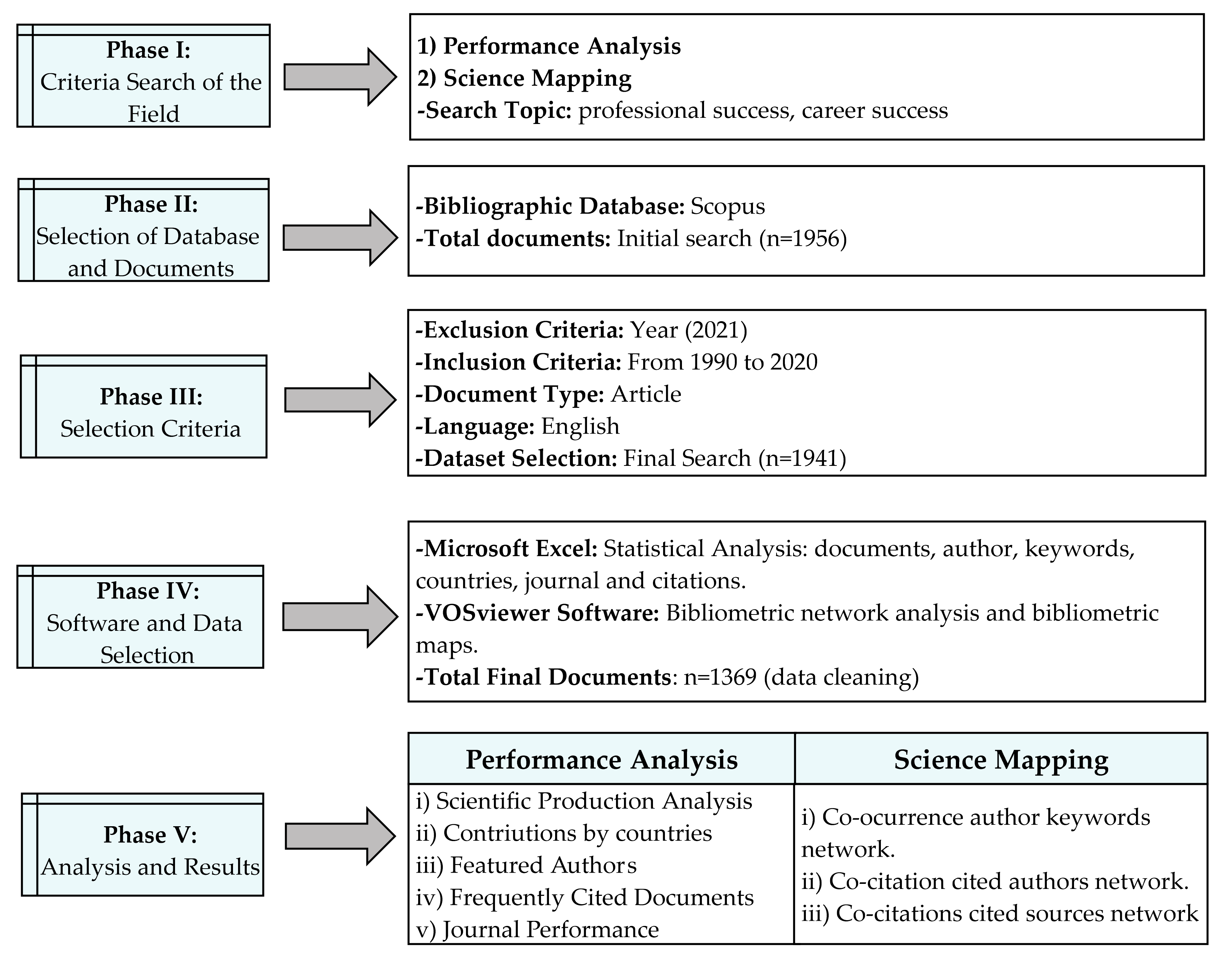
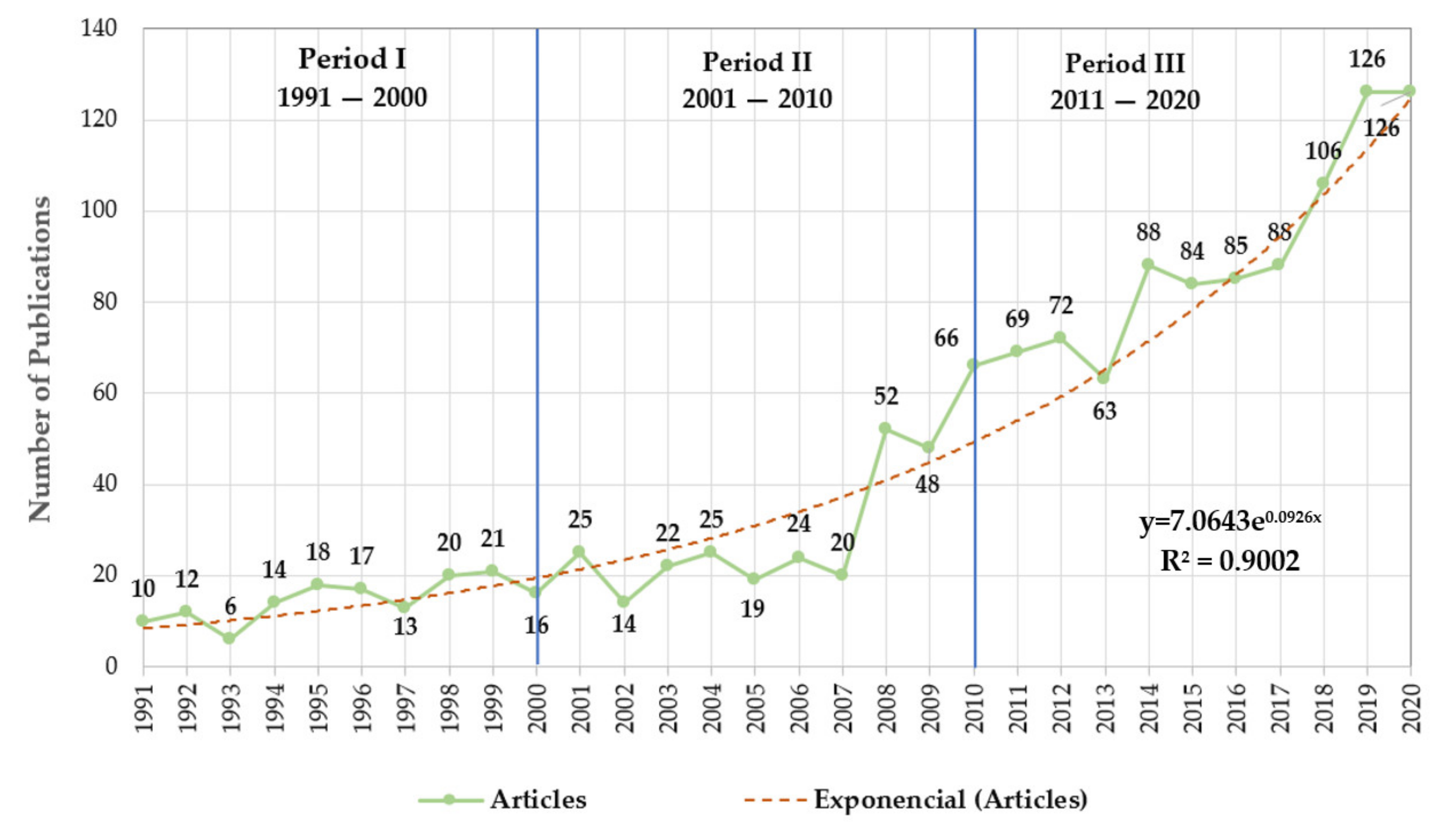
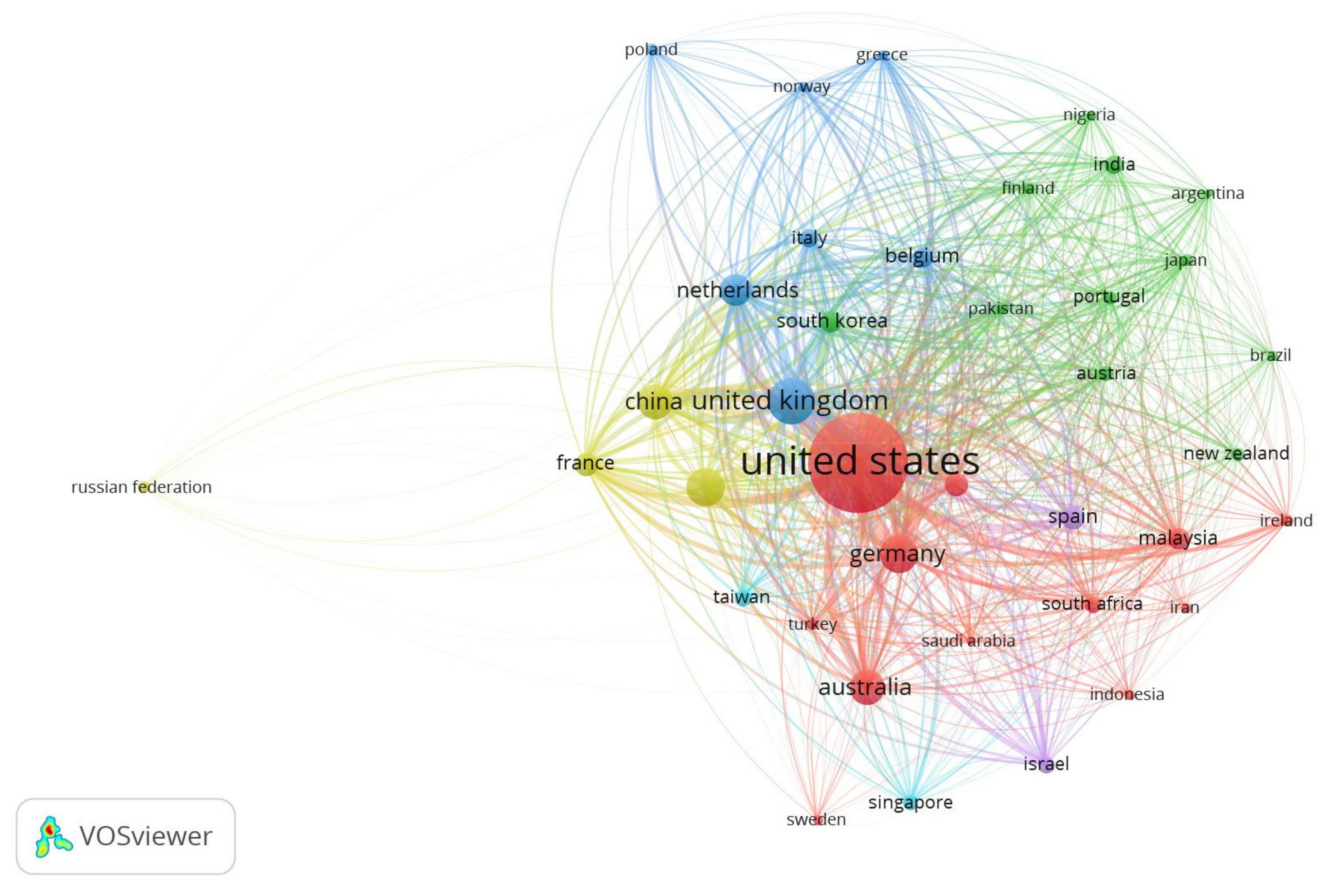
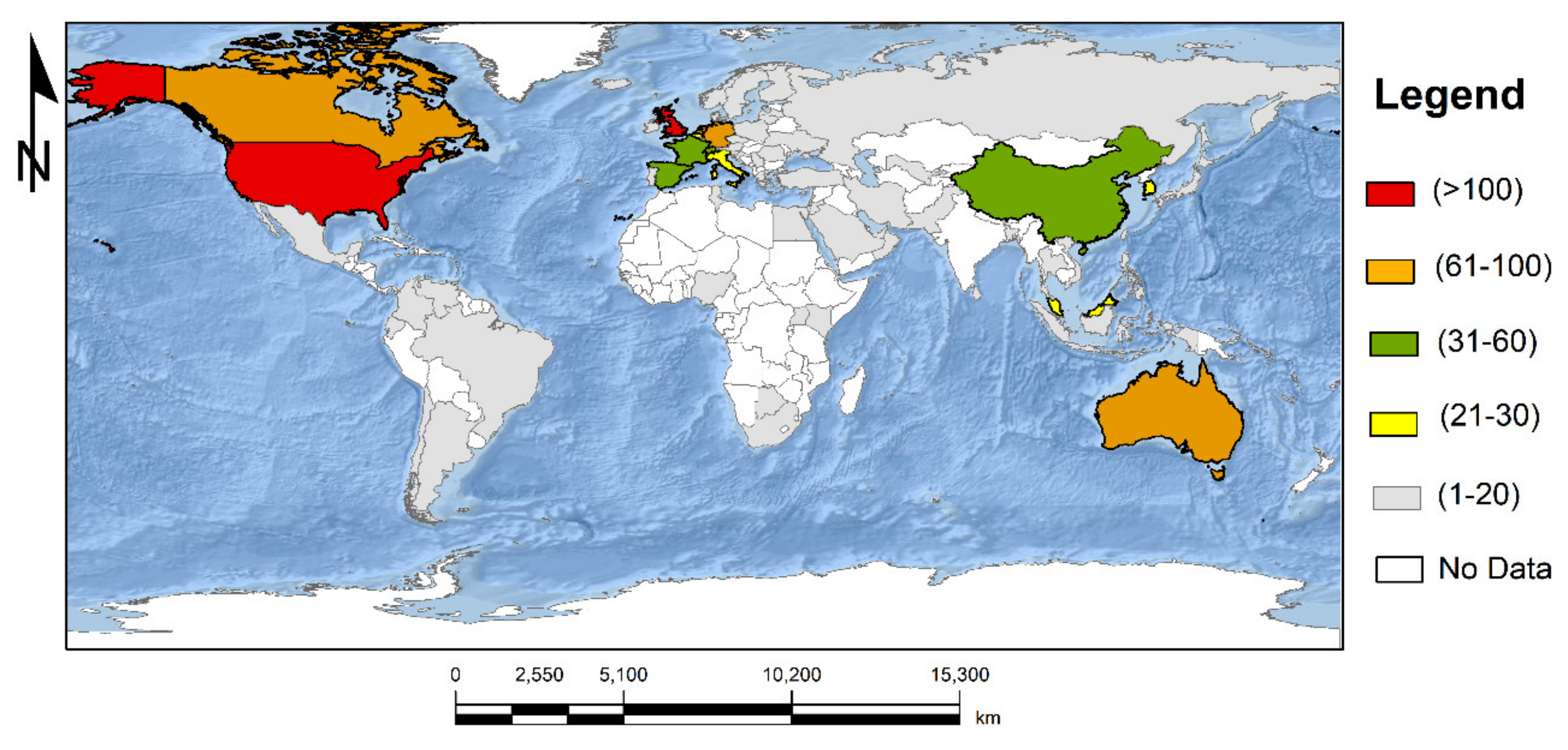
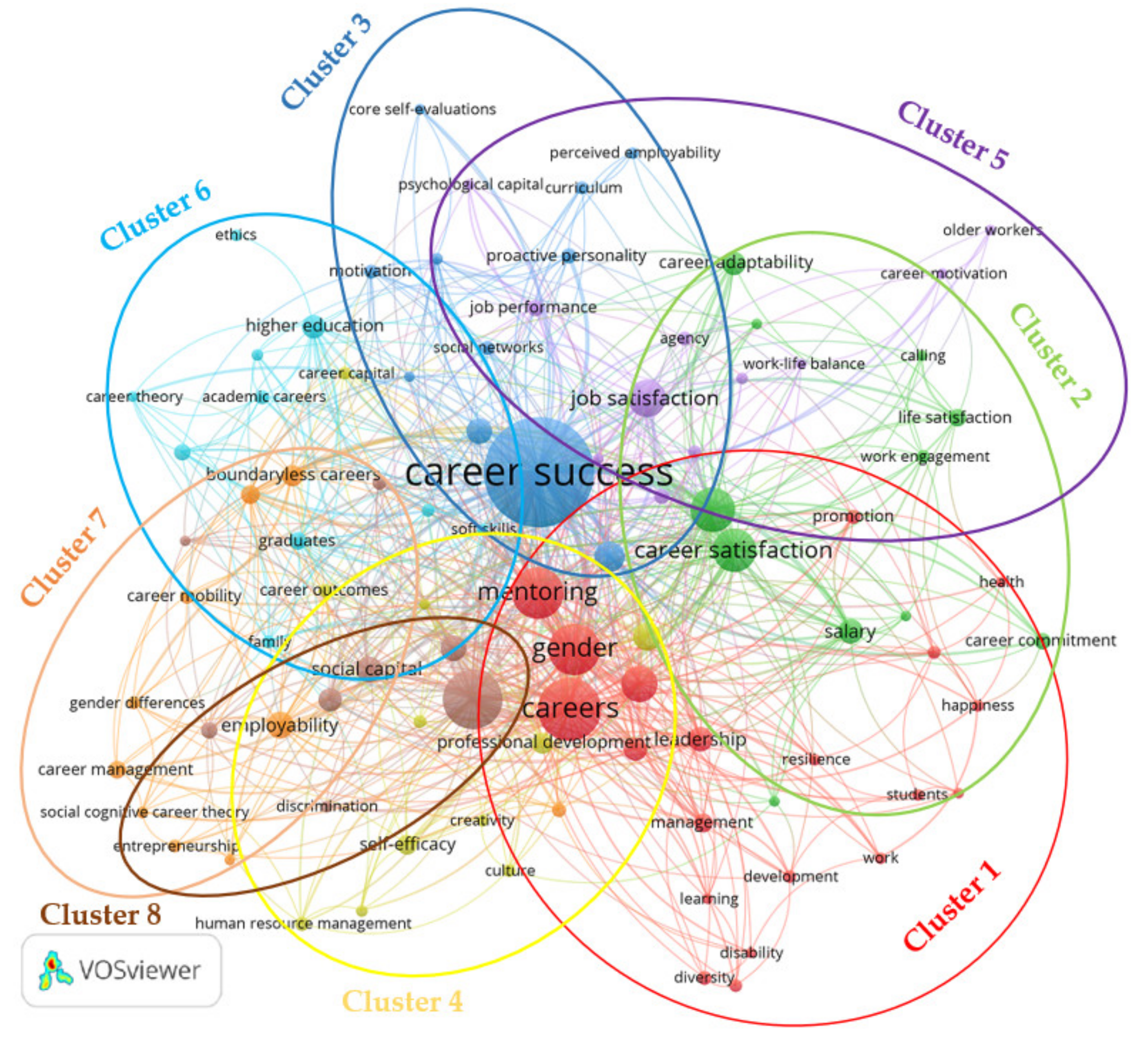
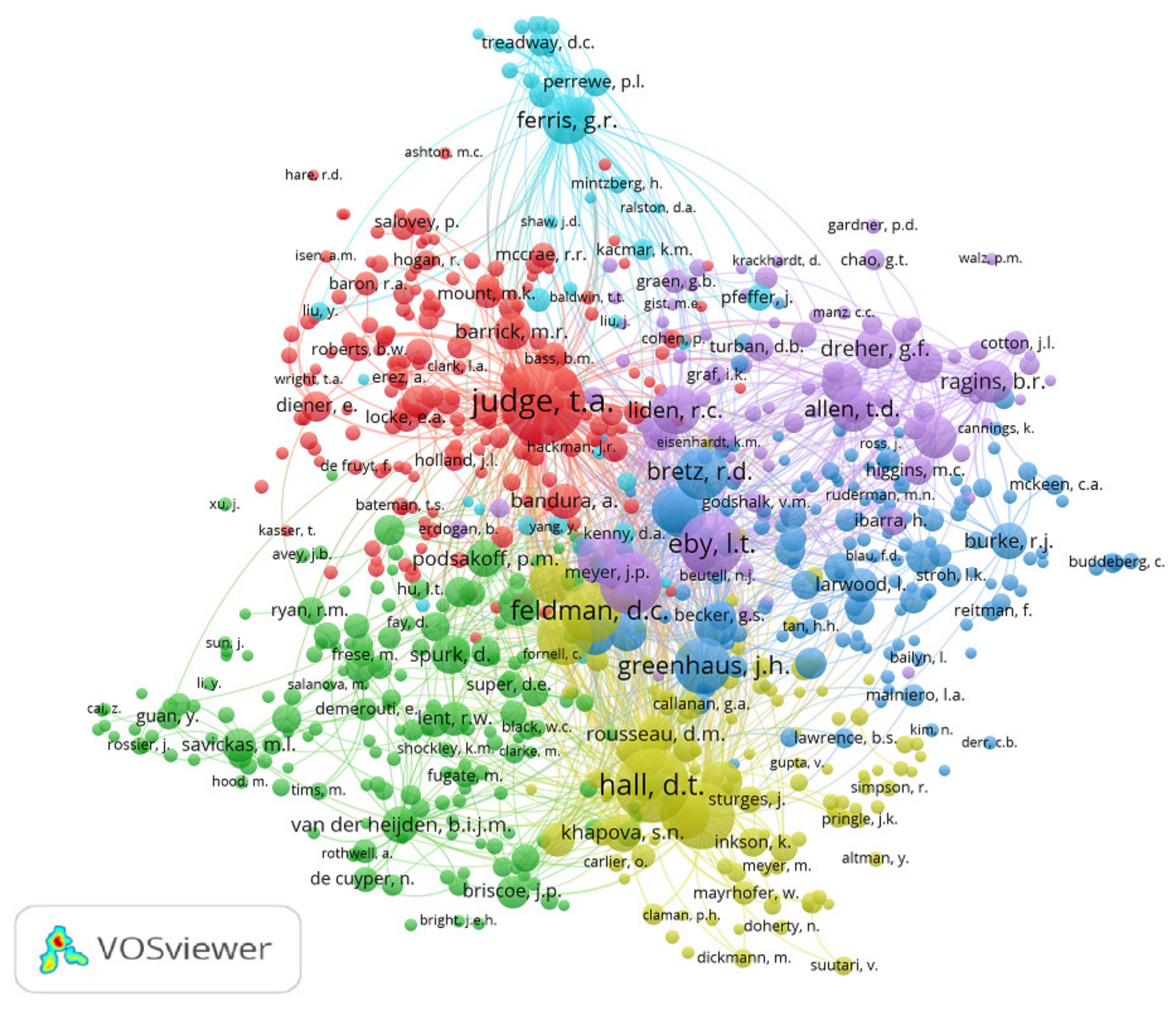
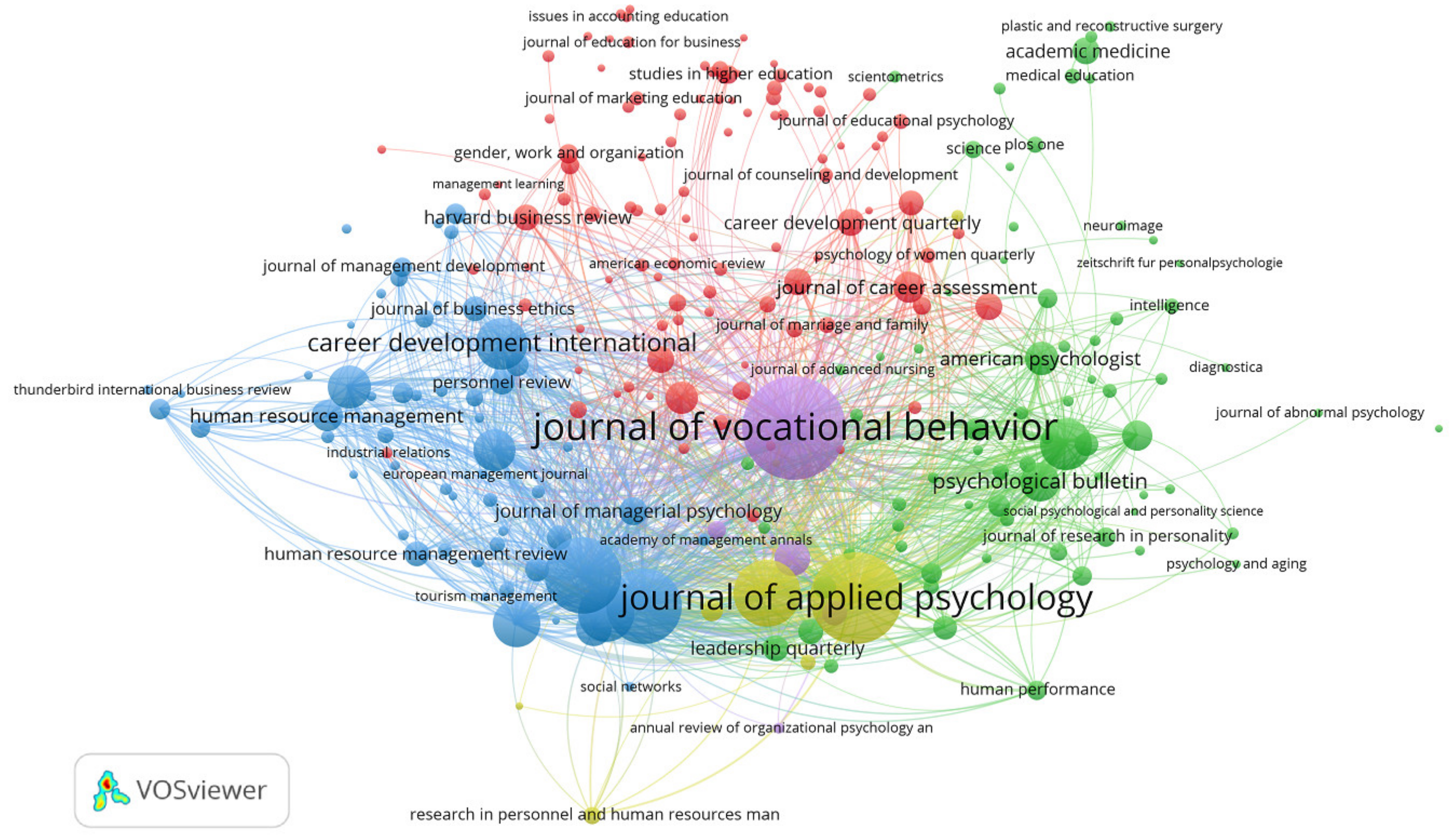
| Ranking | Country | Documents | Citations | Average Citations |
|---|---|---|---|---|
| 1 | United States | 601 | 23,689 | 229,691 |
| 2 | United Kingdom | 133 | 3915 | 101,569 |
| 3 | Canada | 93 | 1609 | 58,473 |
| 4 | Germany | 87 | 2462 | 89,419 |
| 5 | Australia | 75 | 1421 | 45,053 |
| 6 | Netherlands | 61 | 2267 | 66,417 |
| 7 | China | 58 | 701 | 69,785 |
| 8 | Spain | 36 | 367 | 33,966 |
| 9 | Switzerland | 36 | 822 | 31,396 |
| 10 | France | 35 | 789 | 47,363 |
| 11 | Malaysia | 29 | 219 | 36,997 |
| 12 | South Korea | 28 | 188 | 33,891 |
| 13 | Belgium | 25 | 1130 | 43,236 |
| 14 | Hong Kong | 21 | 786 | 27,398 |
| 15 | Italy | 21 | 172 | 28,852 |
| Author | Institution | Country | Documents | Citations | H-Index |
|---|---|---|---|---|---|
| Judge T.A. | Fisher College of Business | United States | 14 | 3837 | 89 |
| Spurk D. | University of Bern | Switzerland | 14 | 695 | 19 |
| Zhou W. | Renmin University of China | China | 12 | 241 | 10 |
| Baruch Y. | Southampton Business School | United Kingdom | 11 | 330 | 42 |
| Burke R.J. | Schulich School of Business | Canada | 11 | 165 | 53 |
| Abele A.E. | Friedrich-Alexander-Universität Erlangen-Nürnberg | Germany | 10 | 650 | 32 |
| Bozionelos N. | Emlyon Business School | France | 10 | 502 | 22 |
| Hirschi A. | University of Bern | Switzerland | 10 | 241 | 29 |
| Blickle G. | Universität Bonn | Germany | 9 | 207 | 21 |
| Van Der Heijden B.I.J.M. | Universiteit Gent | Belgium | 9 | 861 | 40 |
| Buddeberg-Fischer B. | Rehabilitation Clinic Seewis (GR) | Switzerland | 8 | 339 | 25 |
| Kraimer M.L. | Rutgers University-New Brunswick | United States | 8 | 3478 | 30 |
| Orpen C. | The Business School at BU | United Kingdom | 8 | 206 | 20 |
| Otto K. | Philipps-Universität Marburg, | Germany | 7 | 49 | 14 |
| Seibert S.E. | Rutgers University-New Brunswick | United States | 6 | 3016 | 21 |
| R | Authors | Year | Article Title | Citations | References |
|---|---|---|---|---|---|
| 1 | Seibert S.E., Kraimer M.L., Liden R.C. | 2001 | A social capital theory of career success | 1221 | [63] |
| 2 | Judge T.A., Higgins C.A., Thoresen C.J., Barrick M.R. | 1999 | The big five personality traits, general mental ability, and career success across the life span | 1062 | [64] |
| 3 | Judge T.A., Cable D.M., Boudreau J.W., Bretz R.D., Jr. | 1995 | An Empirical Investigation of the Predictors of Executive Career Success | 766 | [83] |
| 4 | Seibert S.E., Kraimer M.L., Crant J.M. | 2001 | What do proactive people do? A longitudinal model linking proactive personality and career success | 738 | [87] |
| 5 | Seibert S.E., Grant J.M., Kraimer M.L. | 1999 | Proactive personality and career success | 723 | [8] |
| 6 | Nosek B.A., Spies J.R., Motyl M. | 2012 | Scientific Utopia: II. Restructuring Incentives and Practices to Promote Truth Over Publishability | 552 | [129] |
| 7 | Van Der Heijde C.M., Van Der Heijden B.I.J.M. | 2006 | A competence-based and multidimensional operationalization and measurement of employability | 450 | [90] |
| 8 | Parasuraman S., Purohit Y.S., Godshalk V.M., Beutell N.J. | 1996 | Work and family variables, entrepreneurial career success, and psychological well-being | 438 | [130] |
| 9 | Eby L.T., Butts M., Lockwood A. | 2003 | Predictors of success in the era of the boundaryless career | 436 | [131] |
| 10 | Judge T.A., Cable D.M. | 2004 | The effect of physical height on workplace success and income: Preliminary test of a theoretical model | 398 | [101] |
| 11 | Bretz R.D., Judge T.A. | 1994 | Person-organization fit and the theory of work adjustment: Implications for satisfaction, tenure, and career success | 369 | [132] |
| 12 | Fuller Jr. B., Marler L.E. | 2009 | Change driven by nature: A meta-analytic review of the proactive personality literature | 332 | [88] |
| 13 | Spangler W.D. | 1992 | Validity of questionnaire and TAT measures of need for achievement: Two meta-analyses | 327 | [19] |
| 14 | Seibert S.E., Kraimer M.L. | 2001 | The Five-Factor Model of Personality and Career Success | 322 | [5] |
| 15 | Rothwell A., Arnold J. | 2007 | Self-perceived employability: Development and validation of a scale | 310 | [91] |
| Journals | Articles | Citations | Citescore | SJR | SNIP | H-Index |
|---|---|---|---|---|---|---|
| Journal of Vocational Behavior | 90 | 7103 | 6.3 | 2.210 | 2.551 | 141 |
| Career Development International | 80 | 1763 | 3.6 | 1.052 | 1.600 | 56 |
| International Journal of Human Resource Management | 34 | 822 | 5.5 | 1.263 | 1.885 | 107 |
| Journal of Career Development | 27 | 504 | 3.1 | 0.564 | 1.356 | 41 |
| Journal of Career Assessment | 14 | 349 | 4.1 | 1.119 | 1.694 | 56 |
| Frontiers in Psychology | 12 | 62 | 3.2 | 0.914 | 1.200 | 95 |
| Human Resource Management | 11 | 658 | 8.5 | 2.322 | 3.094 | 87 |
| Journal of Applied Psychology | 11 | 2030 | 10.7 | 6.423 | 3.692 | 269 |
| Journal of Occupational and Organizational Psychology | 11 | 611 | 5.1 | 1.774 | 2.092 | 106 |
| Journal of Managerial Psychology | 11 | 428 | 3.9 | 1.046 | 1.542 | 74 |
| Journal of Organizational Behavior | 11 | 1132 | 9.7 | 3.606 | 3.273 | 164 |
| Human Relations | 10 | 300 | 7.1 | 2.519 | 3.043 | 124 |
| Journal of Management Development | 10 | 194 | 3.2 | 0.516 | 1.207 | 55 |
| Personnel Psychology | 10 | 2968 | 2 | 0.351 | 0.597 | 133 |
| Personnel Review | 9 | 417 | 3 | 0.841 | 1.458 | 67 |
| Ranking | Author | Citations | Total Link Strength | Country | Affiliation |
|---|---|---|---|---|---|
| 1 | Judge, T.A. | 1044 | 72,460 | United States | Fisher College of Business |
| 2 | Hall, D.T. | 825 | 52,462 | United States | Questrom School of Business |
| 3 | Arthur, M.B. | 688 | 42,638 | United States | Suffolk University |
| 4 | Eby, L.T. | 608 | 41226 | United States | The University of Georgia |
| 5 | Kraimer, M.L. | 575 | 42,599 | United States | Rutgers University–New Brunswick |
| 6 | Feldman, D.C. | 550 | 36,412 | United States | Terry College of Business |
| 7 | Greenhaus J.H. | 481 | 28,938 | United States | LeBow College of Business |
| 8 | Seibert, S.E. | 473 | 33,726 | United States | Rutgers University–New Brunswick |
| 9 | Ng, T.W.H. | 317 | 23,111 | Hong Kong | The University of Hong Kong |
| 10 | Bretz, R.D. | 416 | 24,930 | United States | Mendoza College of Business |
| 11 | Ferris, G.R. | 361 | 33,093 | United States | Florida State University |
| 12 | Liden, R.C. | 361 | 28,532 | United States | University of Illinois at Chicago |
| 13 | Baruch, Y. | 359 | 24,775 | United Kingdom | University of Southampton |
| 14 | Boudreau, J.W. | 341 | 22,979 | United States | USC Marshall School of Business |
| 15 | Cable, D.M. | 326 | 21,715 | United Kingdom | London Business School |
| Ranking | Source | Citations | Total Link Strength |
|---|---|---|---|
| 1 | Journal of Vocational Behavior | 3285 | 123,291 |
| 2 | Journal of Applied Psychology | 2591 | 109,959 |
| 3 | Academy of Management Journal | 1806 | 79,296 |
| 4 | Journal of Organizational Behavior | 1726 | 71,863 |
| 5 | Personnel Psychology | 1387 | 61,486 |
| 6 | Journal of Management | 983 | 47,266 |
| 7 | Career Development International | 838 | 34,509 |
| 8 | Journal of Personality and Social Psychology | 822 | 37,840 |
| 9 | Academy of Management Review | 710 | 33,172 |
| 10 | International Journal of Human Resource Management | 564 | 26,115 |
| 11 | Human Relations | 547 | 25,063 |
| 12 | Psychological Bulletin | 476 | 22,701 |
| 13 | Journal of Occupational and Organizational Psychology | 405 | 18,544 |
| 14 | Administrative Science Quarterly | 403 | 19,052 |
| 15 | American Psychologist | 341 | 15,483 |
Publisher’s Note: MDPI stays neutral with regard to jurisdictional claims in published maps and institutional affiliations. |
© 2021 by the authors. Licensee MDPI, Basel, Switzerland. This article is an open access article distributed under the terms and conditions of the Creative Commons Attribution (CC BY) license (https://creativecommons.org/licenses/by/4.0/).
Share and Cite
Pico-Saltos, R.; Carrión-Mero, P.; Montalván-Burbano, N.; Garzás, J.; Redchuk, A. Research Trends in Career Success: A Bibliometric Review. Sustainability 2021, 13, 4625. https://doi.org/10.3390/su13094625
Pico-Saltos R, Carrión-Mero P, Montalván-Burbano N, Garzás J, Redchuk A. Research Trends in Career Success: A Bibliometric Review. Sustainability. 2021; 13(9):4625. https://doi.org/10.3390/su13094625
Chicago/Turabian StylePico-Saltos, Roberto, Paúl Carrión-Mero, Néstor Montalván-Burbano, Javier Garzás, and Andrés Redchuk. 2021. "Research Trends in Career Success: A Bibliometric Review" Sustainability 13, no. 9: 4625. https://doi.org/10.3390/su13094625
APA StylePico-Saltos, R., Carrión-Mero, P., Montalván-Burbano, N., Garzás, J., & Redchuk, A. (2021). Research Trends in Career Success: A Bibliometric Review. Sustainability, 13(9), 4625. https://doi.org/10.3390/su13094625








